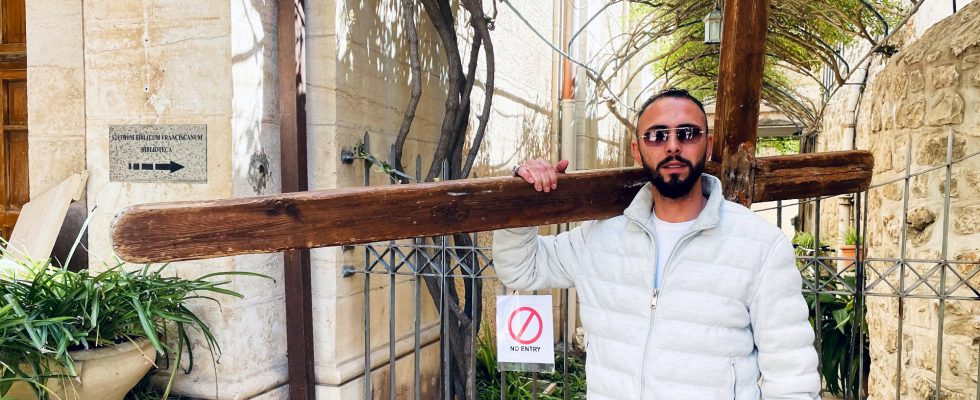Status: 04/07/2023 10:41 a.m
Many Christians are drawn to Jerusalem these days. They want to follow the Way of the Cross – with a cross on their shoulders so that they can better empathize with the suffering of Jesus. They get the cross from a Muslim.
There is probably no one who carried as many crosses down the Via Dolorosa as Mahmoud Kanaan. He has about 50 crosses in stock, some of which are more than 30 years old. Mahmoud is a Muslim and runs a small family business. His grandfather had the idea of renting a cross in 1967.
“We have crosses of different sizes,” he says. He keeps the biggest ones elsewhere. “There are groups, for example from Korea, that want the biggest cross.” The crosses in his shop are half the size. “The crosses here are usually worn on the shoulder and run with them.”
The Via Dolorosa, the Way of the Cross, runs right through the old city of Jerusalem. According to legend, Jesus walked this path from the palace of Pontius Pilate to the place of execution just outside the city gates. And some of the Christian groups of pilgrims want to follow exactly this path – with a cross, in order to be able to feel the suffering of Jesus even better.
Pilgrims carry a wooden cross along the Via Dolorosa in Jerusalem’s Old City during the Catholic Good Friday procession.
Image: AFP
The Via Dolorosa has 14 stations
For Mahmoud, this is a forward transaction – and anything but an easy job: sometimes the groups come at half past six or half past seven, but sometimes as early as five or four. “That’s pretty early. And sometimes I don’t just have to carry one, but two, three or four crosses. Four crosses are very difficult, it’s exhausting. But if they’re happy, I’m too.”
But business is bad, even though most of his crucifixes are still on the move during Holy Week. Mahmoud used to award 20 crosses a day – now it’s sometimes just two.
Strictly speaking, Mahmoud doesn’t earn his money by renting out crosses, but as a photographer. “They call ahead and say: Mahmud, we need a cross at five in the morning. 30, 40 or 50 people come. They tell me the time and then they want photos at each station of the cross. Three photos cost 10 dollars, the cross is free.” The Via Dolorosa has 14 stations – the path of pain. If things go well, there will be a few photos together.
“How painful it was for Jesus”
Those who are there are very different. The most important customers come from Italy and Spain, but Poland, Ireland and the USA are also often represented. “With some groups you can see them crying.” Mahmoud also watches them embrace the cross. “Some just sit on the ground and don’t get any further. You can see that they are very emotional. Some pilgrims need a little time to be able to move on. When they walk the Via Dolorosa, they feel how painful it was for Jesus.”
Respect of other religions important
Mahmoud keeps his crosses halfway between the first station and the Church of the Holy Sepulchre. As a Muslim, the respect of other religions is important to him: “They have their faith and they come as pilgrims, just as we Muslims are pilgrims. This is the Holy Land, holy for everyone. I have respect, take care of them and help them. I show them guide them and try to remove obstacles.”
Good Friday is especially hard every year. Then there are also groups with crowns of thorns, artificial blood is used. And in between: the crosses by Mahmoud. Then he has to keep an overview and collect everything again at the end and prepare it for the next group of pilgrims who want to travel through Jerusalem like Jesus.
Easter in Jerusalem – Each one only a cross
Jan-Christoph Kitzler, ARD Tel Aviv, April 7, 2023 6:40 a.m

